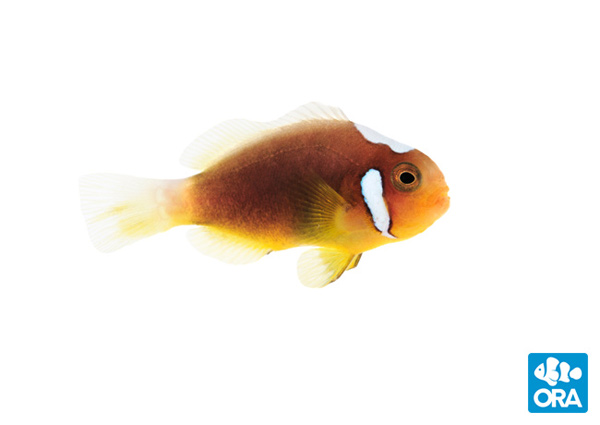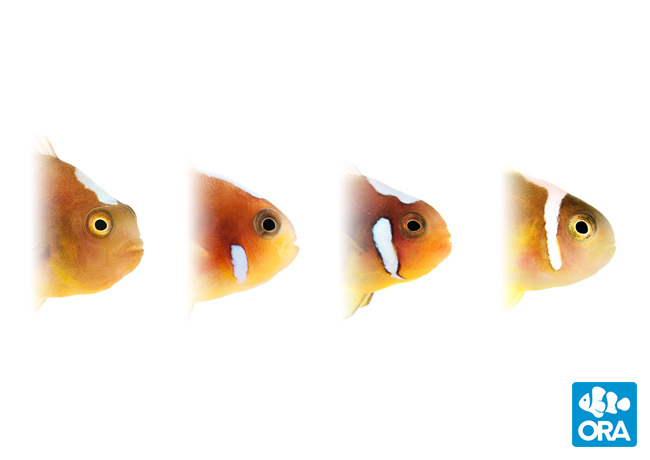
The first commercial scale availability of Amphiprion leucokranos, the White Bonnet Clownfish, comes via ORA.
via the ORA blog
The ORA White Bonnet Clownfish story begins nearly 15 years ago. Over the years we have acquired numerous White Bonnet clownfish in an effort to create harmonious pairs but our success was limited. At one point we even had eggs from a spawning pair in Texas shipped to us, but we never found success raising this species.
Our luck all changed in 2012 when we received a call from our friends at Ocean Gallery II in New Jersey. Not only did they have a spawning pair, they generously offered the fish to ORA in hopes of making this impossibly rare fish more accessible to aquarium hobbyists. Their path south to ORA took a wild detour though. Read more about the tumultuous journey our pair of A. leucokranos endured as they were misplaced, rediscovered and finally arrived to their new home in Fort Pierce, Florida. Click here for the entire story of how we came to find our pair of White Bonnets.
As our new fish settled in and began spawning, our excitement shifted to curiosity. We weren’t sure what to expect from a wild F1 “hybrid” A. leucokranos pair. Would we see offspring with characteristics of the clarkii or skunk complex? How much variation would we see in head striping? To date, there haven’t been any offspring from our pair that strongly resemble A. chrysopterus or A. sandaracinos, the reported parent species of A. leucokranos [CORAL editor’s note – this observations matches the observations reported by Fernando Nostrapour who spawned and reared A. luecokranos some years prior]. Our juveniles have demonstrated variations in body shape that seem to be indicators of their mixed lineage, with some individuals exhibiting the long, leaner body profile of A. sandaracinos and others inheriting the more stocky body of A. chrysopterus. We have also found incredible variation in the head striping patterns, just like those seen in wild specimens. Because of this spectrum of variability, we decided to create a strict grading system for our release of this fish. The product description for our juveniles explains in detail the process by which we grade our White Bonnet clownfish.
Another noticeable characteristic from these captive bred fish is the lack of the bright, apricot coloration of wild fish. In captivity, even adult fish lose this coloration rapidly and for unknown reasons, but from our experience it is related to the genetics of A. chrysopterus. This species is also the slowest growing clownfish we have ever raised at ORA.
ORA is proud to bring such a rare jewel of the reef to the average hobbyist. Ask your local retailer for more details on how you can bring home this unique species of clownfish!
Learn more on our product page here: http://www.orafarm.com/products/fish/clowns/white-bonnet/
Additional notes on the White Bonnet, and ORA’s grading of their offspring – via ORA’s product pages
The White Bonnet Clownfish is an extremely rare hybrid from the Solomon Islands. It is reported to be the naturally occurring cross between A. chrysopterus and A. sandaracinos. While captive specimens rarely exhibit the bright, apricot-like color of their wild counterparts, they do retain the variable nature of the head stripe and cheek bars. The iconic “bonnet” like white head stripe can also show up as cheek dots or broken stripes. These stripes frequently turn blue with age, a trait that comes from the A. chrysopterus side of the family. Rarely found in wild homogenous pairs, this fish is more often seen in mixed pairs with either A. chrysopterus or A. sandaracinos. This species attains a maximum length of about 4 inches and is an absolute delight for avid clownfish collectors or regular hobbyists.
Due to the variable nature of the striping and the rarity of these features, we grade our White Bonnet clownfish very specifically:
AA Grade White Bonnet Clownfish will retain all the features of an idealized wild caught specimen. Complete white head bonnet with connected cheek straps. The premium version of this fish. From our broodstock pair, the male would be considered AA Grade.
A Grade White Bonnet Clownfish will have broken or incomplete white head bonnets. Cheek stripes will reach at least the midpoint of the eye on one or both sides. From our broodstock pair, the female would be considered A Grade.
Standard White Bonnet Clownfish will retain some quantity of white head stripe pattern. Cheek stripes, if present, will not rise above the midpoint of the eye.
Image Credits – all images courtesy ORA





